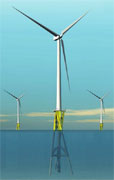At WINDPOWER 2014, taking place this week in Las Vegas, the US Department of Energy (DOE) shared a draft of its Wind Vision initiative, which has a goal of wind providing 35% of electricity 2050.
The final roadmap will be released this fall to reach these goals: 10% wind by 2020; 20% by 2030; and 35% by 2050.
To get there, the industry would add 10 gigawatts a year of onshore and offshore wind, plus repower older sites – as much in the next six years as the past 40. This level of growth would create 140,000 jobs by 2020 and 400,000 by 2050.
"The industry has proven it can manufacture and install more than that per year, so we have the ability to do this," says Jose Zayas, Director of Wind and Water Power Technologies at DOE. "This is achievable."
More Offshore Wind Demo Projects
While we wait for the first offshore wind project to finally be built, DOE announced funding for three more demonstration projects.
Each will receive up to $47 million over the next four years to get the projects in the water by 2017 and to speed deployment advanced technologies.
New Jersey: Fishermen’s Energy will install five, 5-megawatt (MW) turbines three miles off the coast of Atlantic City, testing a twisted jacket foundation that’s simpler and less expensive to manufacture and install. Researchers will also investigate interactions between offshore wind turbines. Recently, NJ regulators rejected Fishermen’s 25 MW project.
In a twisted jacket foundation, three "legs" are twisted around a central column:

Virginia: Dominion Virginia Power will install two, 6 MW turbines 26 miles off the coast from Virginia Beach, to demonstrate methods for installation, operation and maintenance far from shore. It will test hurricane-resilient design and the same twisted jack foundation. Dominion won the second offshore wind auction in the US last year.
Oregon: Principle Power will install five, 6 MW turbines 18 miles from Coos Bay to demonstrate its WindFloat turbine in water over 1000 feet deep. Deepwater Wind is the developer on the project, which could be the first commercial floating wind farm in the US. The majority (60%) of US offshore wind resources are in deep water, including the entire west coast.

Direct-drive turbines from different manufacturers will be used in the three projects. They have fewer moving parts, are cheaper and more reliable than traditional turbines with gears.
DOE says Maine’s floating turbine project didn’t get approved because it needs more engineering and design, awarding Aqua Ventus $3 million to continue that work. Maine has been struggling to get offshore wind going and really wanted the $47 million project. Principle Power and Statoil both pulled out citing parochial politics from the right-wing governor LePage.
With almost 80% of US demand for electricity coming from cities and towns on the coasts, offshore wind has great potential. Studies show it could power the entire east coast, generating $200 billion in economic activity.
Protecting Whales
In other news, Deepwater Wind, which is moving ahead on the nation’s first wind farm off the coast of Rhode Island, agreed to protect extremely endangered right whales. The area is prime habitat for migrating whales.
Developed in concert with environmental groups, Deepwater will:
- use a traffic-light system of red (no construction allowed in early spring) yellow and green periods based on when whales are likely to be in the area.
- slow ships to 10-knots from Nov. 1 through May 15 to prevent collisions
- use noise-reduction and attenuation technologies developed in Europe
- use better surveillance to spot right whales, such as expert ship-based observers; restrict work at night and when visibility is low; and aerial surveillance.
Finally, this article debunks skeptics’ talking points about wind, such as high emissions when you consider turbine lifecycles:
